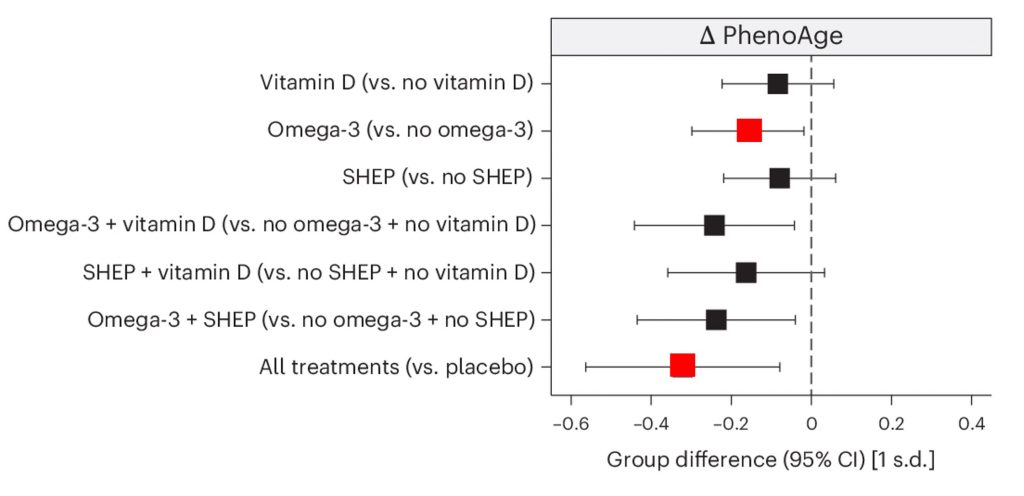Key Points:
- Scientists can estimate how fast or slow we are aging at the cellular level — biological aging.
- Omega-3 supplementation alone slows down aging, and combining omega-3s with vitamin D and exercise slows down aging more.
- Most of us probably don’t get enough of at least one of the three (omega-3s, vitamin D, or exercise), potentially making us age faster.
There’s a reason why you keep hearing about omega-3s, the healthy fats found in fish, such as salmon and sardines. Omega-3 supplements are everywhere, always on the shelves of grocery and vitamin stores. Why? Because you basically need them for your brain to function optimally, both cognitively and emotionally. Not to mention that for each 1% increase in omega-3 levels, there is a 20% decrease in early death.

Suffice it to say, everyone should at least be getting 1 to 1.6 grams of omega-3s per day, or two servings (3 to 4 ounces) of fish per week. Bischoff-Ferrari and colleagues, which includes researchers from Harvard University, have previously shown that omega-3s reduce infections and the rate of falls in older individuals. Moreover, if combined with vitamin D and exercise, omega-3s reduce vulnerability to premature death by 39% and decrease cancer risk by 61%.
Since combining omega-3s with vitamin D and exercise reaps additive longevity benefits, Bischoff-Ferrari and colleagues explored how this combination affects biological aging. They ultimately found that while omega-3s slow biological aging on their own, combining omega-3s with vitamin D and exercise slows biological aging further.
What Is Biological Aging?
We usually think of aging in terms of how many years we have been alive. However, experience tells us that not all people age the same. While genetics play a major role, our rate of aging can be modulated by our choices. For example, consuming excess calories day after day leads to obesity, known to promote premature death, shortening lifespan by over 9 years. Moreover, there is a 3.3-year biological age increase for each 10-unit increase in body mass index (BMI), demonstrating that obesity accelerates biological aging.
In the simplest of terms, biological age is the age of the body, as opposed to chronological age, the number of years we have been alive. Biological age can be measured in many ways with some measures able to predict mortality and chronic diseases. When biological age is higher than chronological age, it indicates age acceleration. When it is lower than chronological age, it indicates slowed aging. Caloric restriction — consuming fewer calories day after day — has been shown to slow biological aging in humans while prolonging the lifespan of animal models.
Aging Clocks and DNA Methylation
Some biological age measurements are based on DNA methylation, a cellular process that adds a methyl group (one carbon atom bonded to three hydrogen atoms) to DNA, typically repressing the transcription of genes. Like other biological age measurements, DNA methylation-based measures can predict the time of death. These DNA methylation-based measures are called epigenetic clocks because they measure biological age based on DNA methylation patterns, which are epigenetic modifications.

Vitamin D and Exercise Enhance Omega-3s Age-Slowing Effects
To determine how combining omega-3s, vitamin D, and exercise affect biological aging, Bischoff-Ferrari and colleagues took advantage of blood samples taken from a previous trial called the DO-HEALTH trial. From the blood samples, the researchers obtained DNA-methylation (DNAm) data from 777 Swiss participants who were physically active older individuals (mean age: 75) free of major chronic diseases, disabilities, and cognitive impairments.
The participants were followed over three years, taking 1 gram of omega-3s (330 mg EPA plus 660 mg DHA from marine algae) per day, taking 2,000 IU of vitamin D per day, and/or performing strength training exercises for 30 minutes three times per week. Each of the three interventions was either administered alone or in combination.
To measure biological aging, the researchers used three epigenetic clocks called PhenoAge, GrimAge, and GrimAge2, which are based on mortality rate data and incorporate lifestyle factors, such as exercise. A fourth clock based on long-term organ system integrity data called DunedinPACE was also used. Rather than measuring biological age, DunedinPACE measures pace-of-aging.
The results showed that when measured with the PhenoAge and GrimAge2 clocks, omega-3 supplementation alone reduced biological age. It also reduced the pace of aging as measured with the DunedinPACE clock. Meanwhile, vitamin D and exercise were not associated with any changes in biological age. Importantly, when measured with the PhenoAge clock, combining omega-3s with vitamin D and exercise additively reduced biological age. That is, biological aging was slowed with omega-3s alone but was slowed further when combined with vitamin D and exercise.

Eat Fish, Not That
Essential nutrients are those that cannot be made by the body and, therefore, must be supplied from food. Because omega-3 fatty acids cannot be synthesized by the body and are an important component of cellular membranes, they are essential nutrients. However, alarmingly, a 2001 study showed that 95% of children and 68% of adults had circulating omega-3 levels below those associated with the Dietary Guidelines for Americans. Moreover, Bischoff-Ferrari and colleagues found that the effect of omega-3s on slowing biological aging was more pronounced in participants with lower omega-3 levels.
The amount of Americans with low omega-3 levels is a concern because a meta-analysis of 17 prospective studies showed that circulating omega-3 levels are associated with an 18% reduction in all-cause mortality and reduced risk of cardiovascular mortality. Furthermore, a meta-analysis of 38 randomized controlled trials showed that supplementing with omega-3s is associated with reducing cardiovascular mortality, heart attacks, and heart disease. These studies, along with Bischoff-Ferrari and colleagues’ new findings, hint that omega-3s are necessary for a long life that isn’t shortened by the leading cause of death in the United States.
Furthermore, according to the National Institute of Health, almost one in four people have low vitamin D levels. While vitamin D likely does not prolong lifespan, as it does not reduce mortality rates, being deficient in vitamin D can increase mortality rates. This may not be a surprise, as vitamin D is an essential nutrient that plays important roles in bone, muscle, nervous system, and immune system health. Vitamin D is made by our body when our skin touches the light of the sun, but it can also be found in the same fatty fish that are abundant in omega-3s, such as salmon, mackerel, and sardines.

Notably, the Mediterranean diet, considered the healthiest diet, lowers the risk of all-cause mortality, which could be explained by improving cardiovascular health. The Mediterranean diet includes omega-3- and vitamin-D-containing fatty fish, which likely contributes to the beneficial effects of the Mediterranean diet on longevity. However, for vegans and those who do not want to eat fish, supplementing with omega-3s and vitamin D may still be a good option.
Act Natural
A meta-analysis of 39 studies showed that physical activity can reduce the risk of mortality by up to 64%. Physical activity and regular exercise also reduce the risk of chronic diseases like cardiovascular disease, type 2 diabetes, obesity, and cancer. Still, only 24.2% of adults are getting enough exercise, according to the Centers for Disease Control.
Many individuals do not get enough exercise for one reason: they don’t have to. With the advent of vehicles, most people don’t need to walk to their destination. Moreover, many individuals sit in a chair all day for work and when at home sit in another chair to watch television or look at their phone. This sedentary lifestyle runs counter to the physical activity our ancestors needed to perform to survive. In this sense, considering that we haven’t evolved to sit all day, being sedentary can be thought of as unnatural.
Meeting Our Basic Needs
Based on the studies above, it does not appear that omega-3s, vitamin D, and exercise potentially prolong lifespan, but merely allow for a normal lifespan. It just so happens that the average American is deficient in essential nutrients and physical activity, leading to a shorter lifespan riddled with chronic disease. The conveniences of society, which include premade foods often lacking essential nutrients, no doubt contribute to the current epidemic of poor health. With that being said, consuming a diet of nutrient-rich foods by avoiding premade foods and performing physical activity can potentially prolong our lifespan while improving our quality of life.